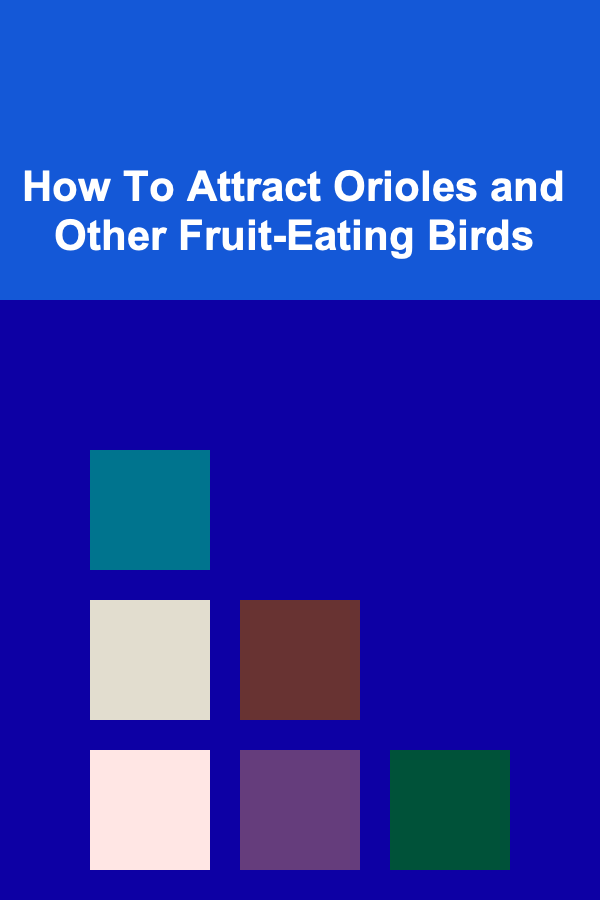
How To Attract Orioles and Other Fruit-Eating Birds
ebook include PDF & Audio bundle (Micro Guide)
$12.99$9.99
Limited Time Offer! Order within the next:

Attracting orioles and other fruit-eating birds to your yard can be an immensely rewarding experience. Not only do these vibrant, colorful creatures add beauty to your surroundings, but they also help control insect populations and contribute to pollination, benefiting your garden. Understanding the preferences of fruit-eating birds and creating a welcoming environment for them requires some preparation and knowledge. This guide will explore various methods for attracting orioles and similar fruit-loving birds to your garden, focusing on food sources, habitat creation, and practical tips.
Understanding Orioles and Fruit-Eating Birds
Before diving into the specifics of attracting orioles and other fruit-eating birds, it's essential to understand their behaviors and dietary needs. Orioles are known for their bright plumage, typically orange and black, and their distinctive, flute-like songs. These birds are not just visually stunning but are also highly migratory, traveling long distances from North America to Central and South America during the colder months.
Fruit-eating birds, in general, are attracted to gardens that provide a variety of natural food sources. Orioles, however, have a preference for certain types of fruits, particularly those that are high in sugar content, like nectar, berries, and tree fruits. Other fruit-eating birds, such as tanagers, mockingbirds, and thrushes, also share similar dietary habits and are often attracted to similar food sources.
By learning about their needs, preferences, and migratory patterns, you can better plan your strategy for attracting these birds to your yard.
Providing Fruit as a Food Source
The primary factor in attracting fruit-eating birds is, unsurprisingly, providing the right kind of food. While orioles and other fruit-eating birds are naturally drawn to nectar-producing flowers, berries, and tree fruits, offering these foods in an accessible and attractive manner can make a significant difference.
Best Fruits to Attract Orioles and Fruit-Eating Birds
-
Oranges
Orioles have a particular fondness for oranges, and offering sliced oranges on a platform feeder or skewered onto a tree branch is an excellent way to entice them into your yard. The citrus scent is alluring, and the sugar content provides energy for these active birds.
-
Grapes
Grapes are another favorite among fruit-eating birds. They enjoy both whole and cut grapes. Grapes are rich in sugar and have a soft texture that is easy for birds to peck at. You can hang bunches of grapes or scatter them on the ground to attract a variety of birds, including orioles.
-
Berries
Berries such as strawberries, blueberries, raspberries, and blackberries are also appealing to orioles and other fruit-eating birds. These fruits are often found in bird-friendly gardens and shrubs, providing an excellent natural food source.
-
Apples and Pears
Both apples and pears, especially when cut into slices, are a great option for attracting fruit-eating birds. These fruits are easily accessible and offer a steady food supply over an extended period.
-
Cherries
Cherries, particularly when they are ripe and juicy, are irresistible to orioles. If you have a cherry tree or a similar fruiting tree, consider leaving a few fruits unharvested or using them in bird feeders to entice birds.
-
Bananas
Bananas may not be a natural food for birds in the wild, but many fruit-eating birds find them incredibly appealing. Slice a banana and offer it on a platform feeder, or skewer it on a branch to attract birds like orioles, waxwings, and mockingbirds.
Methods of Presenting Fruit to Birds
-
Fruit Feeders
A fruit feeder designed to hold slices of fruit, such as oranges or bananas, is an effective way to present fruit to birds. These feeders often feature spikes or hooks that allow the fruit to be securely held in place. Place the feeder in a location where birds feel safe and can easily access the fruit.
-
Platform Feeders
If you prefer a more natural approach, a platform feeder---an open tray or flat surface---is an ideal choice. You can scatter whole grapes, berry clusters, or slices of apples and oranges. Ensure that the tray is kept clean to avoid attracting unwanted pests.
-
Skewering Fruit
Another simple and effective way to offer fruit to birds is by skewering slices of fruit on a branch or feeding pole. You can use toothpicks, small skewers, or even nails to secure slices of orange or apple in an upright position.
-
Hanging Fruit
If you have a tree or a sturdy structure, hanging fruit from strings or nets is an excellent way to mimic the natural way birds feed in the wild. For example, you can thread grapes or slices of orange on twine and hang them from branches.
Offering Nectar and Sugar Water
In addition to offering fresh fruit, orioles and other fruit-eating birds are also attracted to nectar. While many species of birds, including hummingbirds, are well-known nectar feeders, orioles enjoy nectar as well, especially in the spring and early summer months when they are migrating or establishing territories.
Homemade Nectar Recipe for Orioles
Making your own nectar is easy and much cheaper than buying pre-made nectar. Here's a simple recipe for homemade nectar:
-
Ingredients:
- 4 parts water
- 1 part white granulated sugar
-
Instructions:
- Boil the water to ensure it's clean.
- Once it cools to room temperature, stir in the sugar until it's completely dissolved.
- Fill a nectar feeder with the solution and hang it in a shaded area.
It's essential not to use honey or artificial sweeteners, as they can be harmful to birds. Additionally, always clean your feeders thoroughly to prevent mold growth, which can be toxic to birds.
Types of Nectar Feeders
-
Tube Feeders
These are long, slender feeders with holes where the birds can drink from. Orioles are attracted to the sweet liquid, especially if it's hung near trees where they feel safe.
-
Hanging or Platform Feeders
You can also use hanging nectar feeders, which are especially effective in attracting orioles. Platform feeders, which hold multiple cups of nectar, provide an opportunity for orioles to feed alongside other birds, such as hummingbirds.
Planting Native Fruit-Bearing Trees and Shrubs
While offering fruit in feeders is a great way to attract orioles, creating a habitat that provides natural fruit sources can further enhance the attractiveness of your yard. By planting trees and shrubs that produce fruit, you are not only providing food but also offering shelter and nesting sites for birds.
Best Fruit-Bearing Trees for Birds
-
Mulberry Trees
Mulberry trees produce an abundance of sweet, dark berries that orioles and many other birds love. Planting a mulberry tree will attract birds and provide food throughout the growing season.
-
Serviceberry Trees
Serviceberries, also known as Juneberries, produce small, sweet berries that orioles and many other fruit-eating birds enjoy. These trees also provide excellent cover and nesting sites for birds.
-
Cherry Trees
As previously mentioned, cherry trees are a favorite among orioles and other fruit-eating birds. The cherry tree is also a great addition to any garden, offering spring blooms and fall foliage.
-
Elderberry Shrubs
Elderberry bushes produce clusters of small, dark berries that are highly attractive to birds. These bushes are a great choice if you have limited space but still want to offer fruit to your feathered friends.
-
Apple and Pear Trees
Apple and pear trees are wonderful additions to any bird-friendly garden. These trees provide fruit that birds can easily access, and they also offer a bit of shade and shelter.
Planting Tips for Bird-Friendly Gardens
- Diversity: Plant a variety of fruit-bearing trees and shrubs to ensure a continuous food supply throughout the year.
- Native Plants: Whenever possible, choose native fruit-bearing trees and shrubs. Native plants are better adapted to the local environment and provide food and shelter that birds are more familiar with.
- Spacing: Be mindful of the spacing between trees and shrubs. Ensure there's enough room for birds to move between them without feeling cramped or exposed.
Providing a Safe and Inviting Habitat
Birds, especially fruit-eating species, are more likely to visit your yard if they feel safe and secure. Along with providing food, creating a welcoming environment is crucial to attracting orioles and other fruit-eating birds.
Shelter and Cover
Birds need shelter from predators and inclement weather. By planting dense shrubs, trees, and vines, you can provide the necessary cover that makes birds feel comfortable. Dense foliage offers protection, and shrubs or vines can also serve as nesting sites.
Water Sources
Along with food and shelter, birds need access to water for drinking and bathing. A shallow birdbath with clean water is a great addition to your garden. Ensure that the water is refreshed regularly, especially during the warmer months when birds need hydration the most.
Nesting Sites
Orioles and other fruit-eating birds often look for places to build nests, particularly in spring. Planting trees and shrubs that offer sturdy branches and a bit of seclusion is essential for providing nesting opportunities.
Additional Tips for Attracting Fruit-Eating Birds
- Avoid Pesticides: Pesticides can be harmful to both birds and insects. By avoiding the use of pesticides, you help create a safer environment for birds.
- Maintain Clean Feeders: Keep fruit feeders and nectar dispensers clean to prevent the growth of mold or bacteria, which can harm the birds.
- Offer Suet: While fruit is the primary food source, suet cakes, especially those with dried fruit or seeds, can also attract orioles and other birds.
- Create a Bird-Friendly Environment: Avoid loud noises or activities that may scare birds away. Instead, create a calm, peaceful atmosphere where they feel at ease.
Conclusion
Attracting orioles and other fruit-eating birds to your garden is a rewarding and enriching endeavor. By providing a variety of food sources, including fresh fruit and nectar, planting native fruit-bearing trees and shrubs, and ensuring a safe and welcoming environment, you can create a haven for these beautiful creatures. With time, patience, and a little effort, your garden can become a vibrant sanctuary for orioles and other fruit-loving birds, providing you with endless opportunities to enjoy nature's beauty up close.
Reading More From Our Other Websites
- [Personal Care Tips 101] How to Incorporate Toothpaste into Your Daily Oral Hygiene Routine
- [Home Budget 101] How to Save Money on Home Furnishings and Appliances
- [Home Renovating 101] How to Avoid Common Mistakes in a Home Renovation
- [Personal Investment 101] How to Use Economic Indicators to Make Smarter Investment Decisions
- [Home Staging 101] How to Create a Welcoming Entryway for Home Staging
- [Organization Tip 101] How to Utilize Entryway Mats for Organized Shoe Removal
- [Organization Tip 101] How to Declutter Your Mind through Home Organization
- [Sewing Tip 101] Best Techniques for Sewing Heat‑Resistant Protective Clothing for Hobbyists
- [Reading Habit Tip 101] Best Approaches to Blend Language Learning with Your Daily Reading Habit
- [Personal Financial Planning 101] How to Negotiate a Lower Interest Rate on Your Student Loans

How to Effectively Use the Invitation Homes Maintenance Line for Quick Repairs
Read More
How to Use Transparent Bins for Easy Luxury Item Access
Read More
Top Affordable Meal Prep and Planning Resources for Busy Families
Read More
How To Observe Globular Clusters
Read More
How to Master Mind-Muscle Connection
Read More
How To Build a DIY Bar Cart
Read MoreOther Products

How to Effectively Use the Invitation Homes Maintenance Line for Quick Repairs
Read More
How to Use Transparent Bins for Easy Luxury Item Access
Read More
Top Affordable Meal Prep and Planning Resources for Busy Families
Read More
How To Observe Globular Clusters
Read More
How to Master Mind-Muscle Connection
Read More